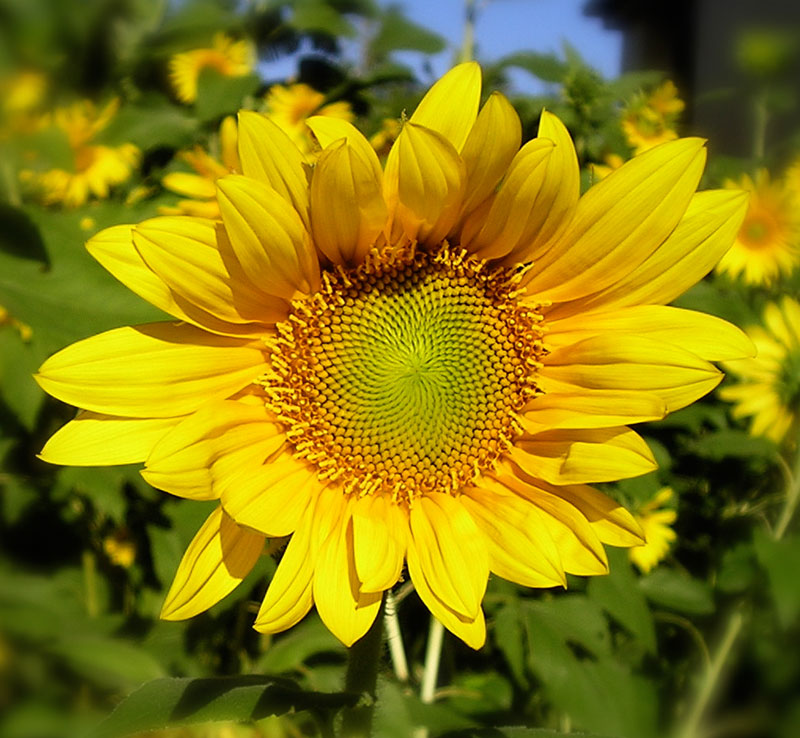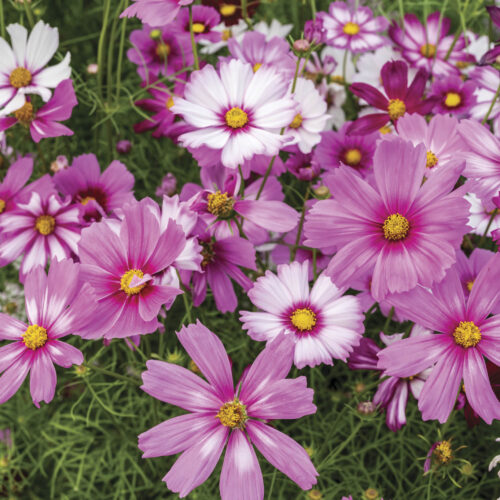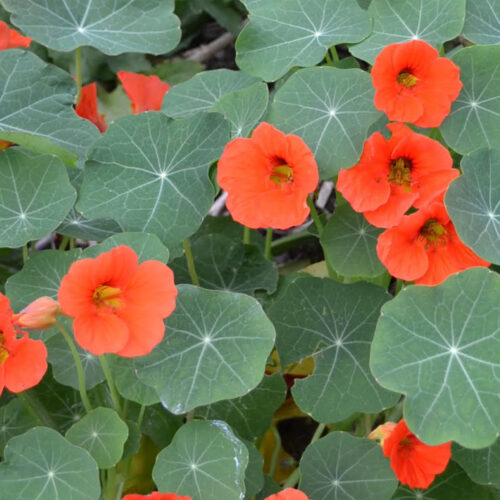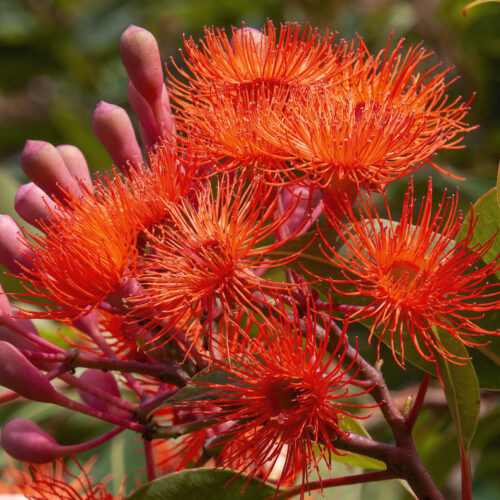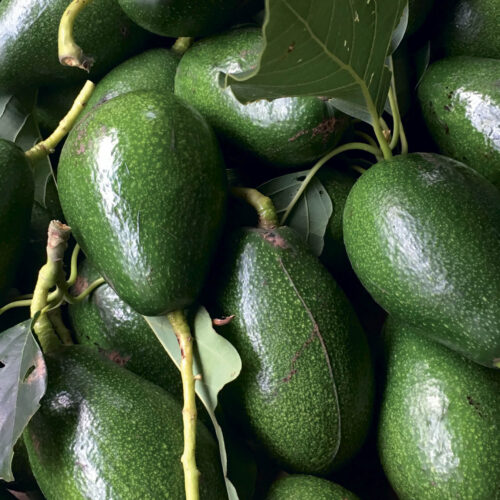Super sunflowers
2009-12-21T22:46:00+11:00
Sunflowers look fabulous, are easy to grow and provide a variety of useful resources, writes JERRY COLEBY-WILLIAMS.
As a child I used various seed mixes for feeding my pet budgerigar, mice and gerbils. Curious to see what sort of plants these blends contained, one Easter holiday I sowed some of each. When the summer school holidays started in my London backyard I had my first crops of chilli, millet, sorghum and sunflowers. Those first sunflowers really caught my eye, just as they did with Francisco Pizarro, a Spanish conquistador, who recorded seeing them being cropped in 16th century Peru.
My plants quickly grew into an imposing row, encircling the front garden. They gave me my first lesson in botany, demonstrating the phenomenon of ‘heliotropism’ where the leaves and flowers follow the sun. This process continues until the flexible part of stem tissue, a region called the pulvinus, hardens as the buds open. The densely-packed spiralled seed heads are rich in protein and oil and highly attractive to birds. For this reason, farmers grow cultivars that droop and hide their flowers, which reduces bird attack.
Food, fibre and oil
Sunflowers, or Helianthus, are native to the Americas. The majority are actually ornamental, frost-hardy, herbaceous perennials. All are easily grown, though only one perennial, the Jerusalem artichoke, H. tuberosus, is widely sold in Australia.
It is the annual sunflower, H. annuus, that is best known to gardeners and that we concentrate on here. Cultivars range in size from dwarfs of less than a metre, to giants that can grow over 3.5m tall and produce flowers up to 50cm across.
Traditionally, indigenous Americans grew the annual sunflower for food, fibre and oil, and they were often sown to provide shelter for crops of maize, pumpkin and beans. Seeds were either roasted or eaten raw, or pressed to make oil. A yellow dye was produced from the flowers. All these uses remain relevant today.
Whole ripe seed heads have become a traditional snack (a nutritious fast food) and seed paste makes an alternative to peanut butter. Sunflowers are an increasingly important oil crop today, with cultivars that yield either monounsaturated or polysaturated oil and, cooking oil is now being recycled for fuel. Sunflowers are also capable of bio-accumulating heavy metals, like lead, and have even been used for removing nuclear fallout around Chernobyl.
While most sunflower cultivars are variations of the classic single yellow-petalled flower surrounded by a broad, dark eye, there is a surprisingly good range of colours (such as orange and rusty red) and heights for the home gardener, as well as many crop-specific cultivars for agriculture (see table).
Growing sunflowers
All the following recommendations depend on your garden’s soil type and fertility, rainfall, drainage and exposure to wind. No season is exactly the same and, ultimately, the weather will determine how successfully they grow. Just remember, sunflowers must have full, all-day sunshine and good drainage to grow strongly. Also, if planting the taller types, make sure they won’t shade other crops or beds.
In cool temperate regions, sow sunflowers in spring, after the last frost, while in warm temperate regions, sow from late winter to late spring. Theoretically, sunflowers can be sown all year round in frost-free subtropical or tropical regions, although for best results grow them from autumn to spring. Hot, wet, humid summer weather increases the risk of a variety of fungal diseases.
Sunflowers are grown from seed. Dig the soil and rake level to create a seed bed. Either broadcast the seed and rake it into the surface or sow seed individually to a depth of 2cm. Covering seed beds with a veneer of chopped sugarcane or lucerne mulch helps retain moisture, keeps the soil cool and reduces pillaging by pigeons and mice. Once the seedlings develop, thin them as necessary.
Water or foliar-feed sunflowers in the morning so foliage is dry before sunset. This reduces the risk of a variety of fungal moulds and rots which can attack all plant parts. For flower displays, allow 10 to 12 weeks for dwarf cultivars to flower, and around 12 to 16 weeks for tall cultivars.
Slugs and snails love sunflower seedlings, so protect them with certified organic snail bait or make your own by mixing one part expresso coffee to three parts water. Spray seedlings and mulch, repeating after heavy rain or irrigation.
Green manure
To grow a sunflower green manure, the aim is to grow a quick, thick, bulky crop of vegetation which can be dug into the ground when seedlings reach about 30cm high. To do this, sow one handful of pet food grade sunflower seed per square metre (this is the cheapest way to buy sunflower seed). Rake the seed into the soil to a depth of around 2cm. Feeding is optional, but regular watering in dry weather is necessary.
To grow a bulkier green manure, where the aim is to use their roots to break uncultivated ground into cultivation (as I did at home), sow half a handful of seed per square metre. This still produces sufficient seedlings for you not to worry about losses caused by slugs and snails. Mulching with a veneer of chopped sugarcane or lucerne improves germination and retains moisture. Water plants regularly in dry weather.
Thin seedlings by hand, leaving only the strongest plants. Thin two or three times until plants are 0.5 metres apart, sufficient for their root action to break up heavy clay soil and for their foliage to help suppress weeds. When plants reach budding stage, slash them down then dig them in.
You can grow a sunflower seed crop in a similar way to a bulky green manure; however, if you grow the ‘Giant Russian’ cultivar the final spacing needs to be 1.5m between plants. In ideal conditions ‘Giant Russian’ exceeds 4m in height and heavy seed heads 0.5m wide are common. If this cultivar is grown in rows or as a small, isolated group, individually staking plants against wind and rain is often needed to prevent plants snapping.
Top crops
If you’re aiming for show-quality flowers or a heavy seed crop, feed plants with two handfuls of poultry manure per square metre when seedlings have reached 15cm high. Then, when plants are 0.5 metres high, mulch with well-rotted cow manure or compost to a depth of 4cm. Foliar feed plants weekly with seaweed.
Some gardeners prefer to remove side shoots to direct energy into producing one large terminal flower. Stake these plants individually. Others prefer to grow shorter, broader plants that produce multiple, smaller flowers. To do this, pinch out the growing point when the plants reach 1m high. With dwarf cultivars pinch out the terminal bud when they reach 0.5m. Traditionally, pinching was practised where sunflowers were bedded out in island beds in lawns, or at the back of mixed perennial borders. For extended flower displays, regularly remove dead flowers.
Sunflowers
- Are one of the fastest growing plants, able to reach two metres in around six months.
- Are great food for poultry and other stock.
- Attract birds to the garden.
- Are a nutritious source of edible seed, also used for sprouting and oil.
Popular Sunflower Cultivars
| Cultivar | Height | Description |
|---|---|---|
| ‘Dwarf Sensation’/aka ‘Dwarf Sunsation’ |
1m | Single-flowered, yellow eye |
| ‘Bronze Shades’/aka ‘Evening Sun’ |
1.5-2m | Single-flowered, red, orange, bronze shades, dark eye |
| ‘Prado Red’ | 1.5-2m | Single-flowered, claret red, dark eye |
| ‘Lemon Queen’ | 1.5-2m | Single-flowered, light yellow, dark eye |
| ‘Italian White’ | 1.5-2m | Single-flowered, creamy-white flowers, dark eye |
| ‘Teddybear’ | 1.5-2m | Double-flowered, deep gold |
| ‘Double Dazzler’ | 1.5-2m | Semi-double, yellow flowers |
| ‘Giant Russian’ | 2.5-4m | Single, yellow flowers to 50cm across, dark eye |
| ‘Galah’ | 2-2.5m | Single, yellow flowers, yellow eye (grown for bird seed) |
| ‘Yellow Empress’ | 2m | Single, large flowers, very dark eye |
Harvest time
I love sunflowers and grow masses of them. It’s because they’re such great multi-taskers. Last year I grew the black oil seed sunflowers, which produce at least twice as much oil as the confectionary type. I had plans to press them for oil, but their first job would be to provide pollen for the bees in the hive – then, when harvested, pressed for oil, the mash that’s left behind is good chook food, and the stalks, dried and chopped down are good fire-starters.
Alas, I didn’t get there before the wild birds last year; I caught them decimating the heads, so I sent in 12 chooks who were like jumping beans for days as they leapt for the dried heads and pecked out seeds – which meant a higher output of gorgeous golden eggs instead.
Harvesting the heads is best left till they are very dry. Once the backs of the flowers begin to yellow can be soon enough to cut them off and store them, upside down, in a dry, well-ventilated place until they dry completely.
Protect seeds from birds
Birds will let you know when they’re ready too – by eating them; in fact, birds are the most significant problem. If you don’t have a lot of sunflowers it can be worthwhile pulling a paper bag over their heads and tying it closed. They look like rows of stooped men waiting for execution.
When ready, the seeds should be relatively loose in the heads; grab a bucket, strike them hard against the side and the seeds will drop into the bucket. A fork to plough out the stubborn seeds can be useful (this is a good job to share with children). If you’ve grown confectionery seed – the grey striped seeds used for ‘people food’ – they can be shelled after being roasted gently in the oven (200°C for a couple of hours). Be sure to stir them regularly to get an even roast.
Oil seed, which is black, is best heated gently before pressing whole – we’ve used a modified car jack to apply sufficient pressure to extract the oil, which drains into a collecting tray. It’s a slow process; the oil that’s pressed is left overnight to settle, then the clean oil is drawn off leaving any sediment behind. This natural cold-pressing technique retains nutrients and results in a strong, nutty flavoured oil which is excellent with salads. You can find detailed instructions on how to make a press and dehuller at http://journeytoforever.org/biofuel_library/oilpress.html

